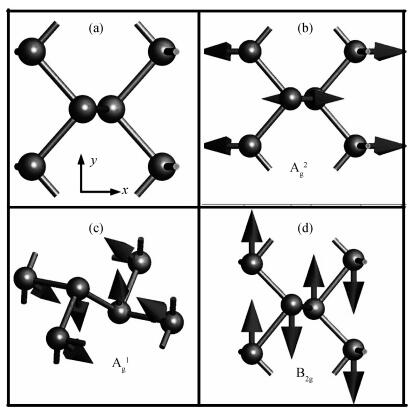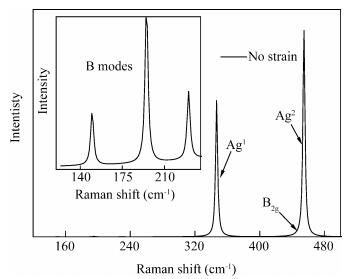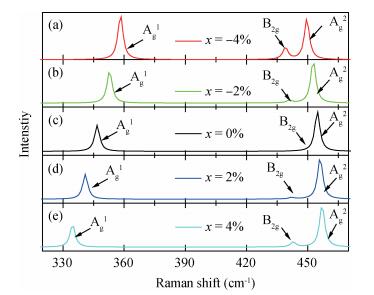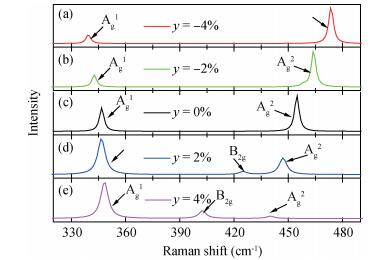| Citation: |
Jiawei Wan, Junhong Guo, Fangren Hu. Identification of strained black phosphorous by Raman spectroscopy[J]. Journal of Semiconductors, 2017, 38(4): 042003. doi: 10.1088/1674-4926/38/4/042003
****
J W Wan, J H Guo, F R Hu. Identification of strained black phosphorous by Raman spectroscopy[J]. J. Semicond., 2017, 38(4): 042003. doi: 10.1088/1674-4926/38/4/042003.
|
Identification of strained black phosphorous by Raman spectroscopy
DOI: 10.1088/1674-4926/38/4/042003
More Information
-
Abstract
Phosphorene has a very high hole mobility and can be a tuned band structure, and has become an ideal material for electronic devices. For this new type of two-dimensional material, in the applied strain, black phosphorus (BP) can be changed into an indirect band gap and metallic materials from the direct band gap semiconductor material, which greatly affect its inherent physical characteristics. How to identify strained microstructure changes becomes an important problem. The calculated Raman spectra disclose that the Ag2 mode and B2g mode will split and the Raman spectra appear, while the Ag1 mode is shifted to low-frequency region. The deformation induced by strain will effectively change the Raman mode position and intensity, this can be used to identify phosphorus changes.-
Keywords:
- black phosphorus,
- strain,
- Raman scattering,
- DFT
-
References
[1] Novoselov K S, Geim A K, Morozov S V, et al. Electric field effect in atomically thin carbon films. Science, 2004, 306: 666 doi: 10.1126/science.1102896[2] Liao L, Lin Y C, Bao M Q. High speed graphene transistors with a self-aligned nanowire gate. Nature, 2010, 467: 305 doi: 10.1038/nature09405[3] Wu Y Q, Lin Y M, Bol A A. High-frequency, scaled graphene transistors on diamond-like carbon. Nature, 2011, 7341: 74 https://www.researchgate.net/publication/51034415_High-frequency_scaled_graphene_transistors_on_diamond-like_carbon[4] Mak K F, Lee C G, James H. Atomically thin MoS2: a new direct-gap semiconductor. Phys Rev Lett, 2010, 105: 136805 doi: 10.1103/PhysRevLett.105.136805[5] Guo J H. Magnetism in alkali-metal-doped wurtzite semiconductor materials controlled by strain engineering. J Appl Phys, 2016, 120: 125101 doi: 10.1063/1.4962857[6] Li L K, Yu Y J, Ye G J. Black phosphorus field-effect transistors. Nat Nanotechnol, 2014, 9: 372 doi: 10.1038/nnano.2014.35[7] Asahina H, Shindo K, Morita A. Electronic structure of black phosphorus in self-consistent pseudopotential approach. J Phys Soc Jpn, 1982, 51: 1193 doi: 10.1143/JPSJ.51.1193[8] Reich E S. Phosphorene excites materials scientists. Nature, 2014, 506: 19 doi: 10.1038/506019a[9] Rodin A S, Carvalho A, Castro N A H. Strain-induced gap modification in black phosphorus. Phys Rev Lett, 2014, 112: 176801 doi: 10.1103/PhysRevLett.112.176801[10] Quereda J, San-Jose P, Parente V, et al. Strong modulation of optical properties in black phosphorus through strain-engineered rippling. Nano Lett, 2016, 16(5): 2931 doi: 10.1021/acs.nanolett.5b04670[11] Fei R X, Li Y. Strain-engineering the anisotropic electrical conductance of few-layer black phosphorus. Nano Lett, 2014, 14(5): 2884 doi: 10.1021/nl500935z[12] Han X Y, Stewart H M, Shevlin S A, et al. Strain and orientation modulated bandgaps and effective masses of phosphorene nanoribbons. Nano Lett, 2014, 14(8): 4607 doi: 10.1021/nl501658d[13] Qiao J S, Kong X H, Hu Z X, et al. High-mobility transport anisotropy and linear dichroism in few-layer black phosphorus. Nat Commun, 2014, 5: 4475 https://www.researchgate.net/profile/Wei_Ji11/publication/262951279_Few-layer_black_phosphorus_emerging_2D_semiconductor_with_high_anisotropic_carrier_mobility_and_linear_dichroism/links/54b3f2b20cf2318f0f96a69c.pdf?inViewer=true&disableCoverPage=true&origin=publication_detail[14] Ling X, Liang L B, Huang S X, et al. Low-frequency interlayer breathing modes in few-layer black phosphorus. Nano Lett, 2015, 15: 4080 doi: 10.1021/acs.nanolett.5b01117[15] Wu J X, Mao N, Xie L M, et al. Identifying the crystalline orientation of black phosphorus using angle-resolved polarized Raman spectroscopy. Angew Chem Int Ed Engl, 2015, 54: 2366 doi: 10.1002/anie.201410108 -
Proportional views






 DownLoad:
DownLoad:


















